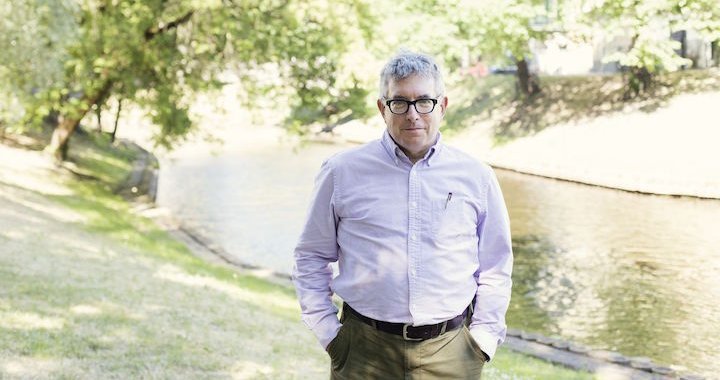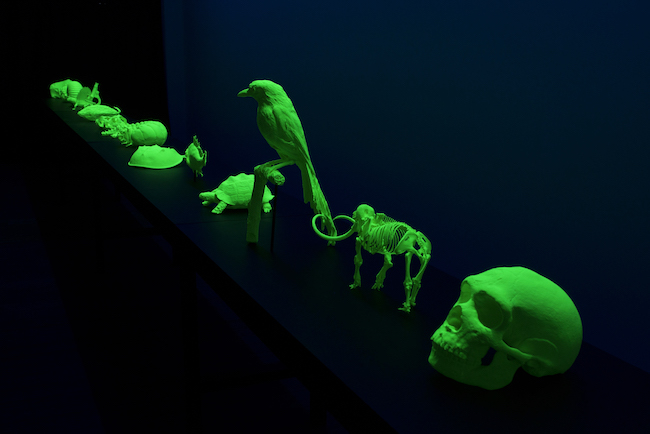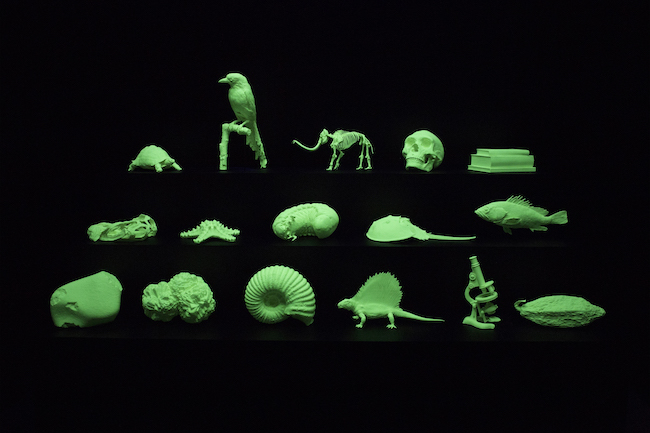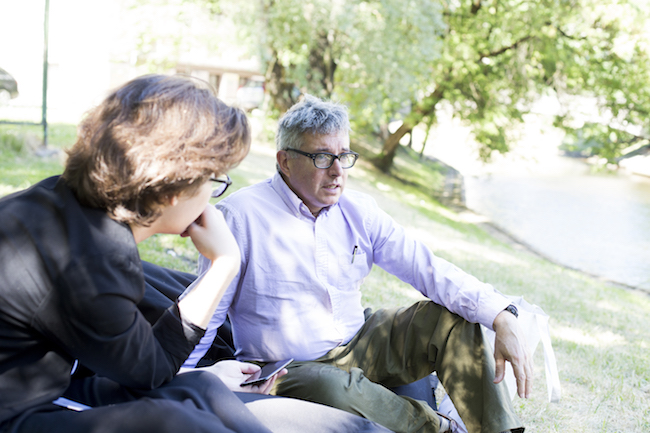
Being a dilettante is exciting
A conversation with American artist Mark Dion
29/06/2018
American artist Mark Dion has often called himself a dilettante, even though his achievements indicate the exact opposite. In early 2018 he had a large solo show, called Theatre of the Natural World, at the Whitechapel Gallery in London. His work has also been displayed at well-known museums and exhibition halls elsewhere throughout the world, including MoMA PS1 in New York City, the Guggenheim Museum Bilbao and London’s Tate Modern.
Most of the material available on the internet regarding Dion describes him as a “conceptual artist”, although he rejects this label. In fact, it’s difficult to describe Dion’s work in a single word or phrase. He is a researcher of the environment, an archeologist, an educator, etc. He began his career as an art restorer and has since focused on the fusing of a number of very different disciplines. Involving a wide variety of other people in his projects – experts in their fields as well as volunteers – he takes on challenging and time-consuming field studies, the result of which can be seen in the exhibition halls.
Dion creates taxonomic installations full of commentary about how the prevailing ideological and educational institutions influence people’s outlooks on history, the natural environment and the world in general. Having collected and selected various found objects, plants and even animal skeletons, he then pursues a careful process of arranging and categorising them. His installations include an almost limitless quantity of specimens, from early Roman potsherds to screw caps from bottles. By using seemingly ordinary, mundane fragments of history instead of artefacts normally found in museums, he turns our attention to a past that would otherwise go unnoticed.
Dion’s installation A Tour of the Dark Museum has been on display at the University of Latvia's former Faculty of Biology building since May 30. It arrived here as a part of the first Riga International Biennial of Contemporary Art. I met Dion on the opening day of the biennial for a conversation in Kronvalda Park, near the Faculty of Biology.

Mark Dion. Part of installation A Tour of the Dark Museum, 2018. Photo: Andrejs Strokins
Do you still consider yourself a dilettante?
I still shadow scientific disciplines, and I’ve learned quite a lot about biology, archeology and restoration over the course of thirty years, but I’m neither a biologist nor an archaeologist nor, to some extent, a conservator. The things I do in my work as an artist differ from the things scientists do. They feel a greater sense of responsibility when it comes to their own practice. I don’t have to be completely truthful towards my audience, and I’m not obliged to stick to certain defined methods or approaches to my work.
I don’t consider dilettantism to be something dubious. Although nowadays the term has garnered a lot of negative connotations, I perceive it by its original meaning. That being an individual who is interested in everything. Every form of life and art. Being a dilettante is exciting, because dilettantes are motivated by passion, not only by work and responsibility. And that’s exactly why they have a lot to bring to a conversation. I think the idea of increased specialisation doesn’t do much good to our culture. It denies groups of people to have meaningful conversation with one another, because these conversations demand knowledge in specific intellectual fields. Dilettantes are people located somewhere in between, therefore they are the most open-minded members of society. They aren’t subjugated by any academic field or system of thought.
So you’re saying that knowledge in specific academic fields can hinder a conversation?
I’ve noticed such a thing, yes. I’m not questioning the need for specialists in certain academic or scientific fields, though. But academic disciplines tend to isolate specialists from people who represent different walks of life. That can trigger a chain of misunderstandings and arouse scepticism and fear towards these disciplines. You see it every day. A lot of people are alarmed or afraid of the rather swift pace that the research of genetics is developing. One of the main reasons is that nobody can explain it to them in an understandable, short-spoken form.
Your work as an art conservator has surely influenced your artistic practice.
The ability to restore and conserve works of art helped me understand the reality of things. I started to view things differently. Paintings, for example. I was able to look past the illusory – the things the artist had conjured up in the composition. I approached the tangible, the physicality of the elements that create images. By getting to know the materiality of works of art, I started to approach my own work differently. I’m not a painter, but I know how to restore paintings. Therefore I comprehend the way paintings are made and the way they change over time. The way paint interacts with the canvas.
The same can be said about objects. Knowledge in the field of art conservation helped me understand what the objects incorporated in my work went through. Materiality plays an important role in my work. I’m not interested in dematerialised works of art, because I don’t consider myself to be a conceptual artist. I don’t think art can be an idea alone. I think it needs a body, a tangible form in which the idea can manifest itself.
So you don’t think a work of art can be, for example, an empty, quiet space?
I think art must manifest itself in a material form. It needs to take up some kind of physical space. Even the conceptualists materialised their work in a space. A work that consists of silence alone I would consider to be some kind of sophistic joke, not a work of art.
Could you elaborate on the idea behind A Tour of the Dark Museum exhibited in the Faculty of Biology here in Riga?
The title of the work references the building itself and its history. It’s not only about the work that was done in the building some time ago. It’s about recent history as well. When I first came to Riga earlier this year, the building caught my attention. I found it fascinating. It’s full of old furniture, skeletons, laboratory equipment, etc. All of this material is in a state of chaos and disarray. It was a rather sad sight. And I thought it would be absurd to transform it into a sterile white cube. I wanted to theatrically recreate the feeling I had when I first visited the building. By that I mean – I wanted to see this space in a sort of mysterious aura. I wanted to recreate that strange feeling of curiosity that I had experienced.
Do you feel more comfortable working in such spaces rather than sterile gallery exhibition halls?
My work is always centred on the spaces in which it is exhibited. It relies on a certain number of aspects. On the space itself and the social and political context of the space, for example. On all of these things that help me determine the character of the space. I find it difficult to work with white walls and concrete floors that don’t give you much context to work with. The former Faculty of Biology building is full of history. In this case there was a lot to work with! That’s why I wanted to create a spooky aura for the work. I wanted to represent the work in this aura, even exaggerate it. It chimed with the context that the space created.

Mark Dion. Installation A Tour of the Dark Museum, 2018. Photo: Kristīne Madjare
Though the overall feeling I got from your work is that all of the objects put on display are displaced, out of context.
I think that’s an adequate reaction. These objects are, to a certain extent, forgotten. In that sense my work is a commentary of an approach to the scientific research of natural things. I’m trying to speak about a scientific method that’s gradually becoming less and less relevant in the scientific community of today, thanks to the development of new technology. Modern-day research doesn’t rely on the observation of things in nature, on real field work. The empirical method has also started disappearing from laboratories. Most things get done on screens and databases. In that sense the objects visible in the work are scientific relicts that tell the story of irrelevant, “old-school” approaches to scientific research. I still consider these approaches crucial. I am drawn to the empirical method and am interested in viewing nature directly, without any kind of buffer.
In a sense, you’re trying to take a few steps back with this work?
Yes, in a certain way. But I’m also mourning the loss of traditional scientific methods. Seeing all of these artefacts in a state of disarray makes me want to emphasise the moment of ruin.
Do you think science has become dehumanised?
To a certain extent, yes. Scientists analyse things that are impossible to observe in nature without the help of technology. Technology enables them to research such things. Of course, this is crucial to science, but they are extremely specific and have little to do with the actual day-to-day interactions between human beings and nature. This is one of the reasons why people are gradually becoming more and more detached from nature. Technology creates an artificial distance from nature.
So you can understand most people’s anxieties when it comes to the advancement of technology?
Yes, I think they stem from the specific character of modern-day science. I think most people would find it difficult to start a conversation about molecular biology with a molecular biologist. They would probably refrain from doing so, because the conversation would entail everyone involved to have a certain amount of knowledge in the field of genetics, molecular chemistry and a chain of other things. I’m not talking about old-fashioned purists who refuse to acknowledge any new form of methodology. I’m talking about the fact that most people do not have access to these new methods, and therefore they are alien to them. Things that are alien can cause confusion and even fear. People feel threatened.
You’ve previously stated that you’ve found it difficult to adapt scientific methods to your work as an artist. Has this changed as you’ve become well-acquainted with these methods over time?
I’m still thinking about the same questions I asked myself when I started. I’m still trying to understand the language of science that we use to explain the processes visible in nature. Of course, science doesn’t have a monopoly on what can be considered nature. At the same time, science is the structure I use to understand nature. I find the question of science’s role in the representation of nature very interesting and vital. I think we need people between scientists and the rest of society. People who can ask these questions and explain these processes in less-complicated language. That way they could bring a crucial part of society closer to science. Although in many cases journalists who write about science have a visible or hidden ideological agenda that makes people think they’re an untrustworthy source for information. And therefore society trusts scientists even less.
Do artists who deal with scientific subject matter in their work have to try to be ideologically neutral?
No, I don’t think that is the responsibility of an artist. An artist doesn’t have to be a reporter. Works of art always embody a subjective point of view. They represent the position and views of their author. Artists don’t have to tell the truth. That should be the task of a journalist.
But a large portion of modern-day journalism has become a form of subjective writing. You previously stated that journalists hold ideological positions.
Yes. In some cases it is beneficial, but at the same time such forms of journalism can muddy the flow of information.
I’d like to know what exactly makes objects interesting to you. You incorporate seemingly bland, everyday objects in your work. What draws you to them?
One of the most important factors that draws me to certain objects is time. When I select objects for a work, I find it very important to observe the effect time has left on them. It is interesting for me to see what they have lived through. That they have had difficult “lives”, and that they have been part of other people’s lives. This is important to me on a personal level.
Objects are very important when I’m creating an illusory space. By placing everyday objects beside one another, you create context within the context of the space you are exhibiting them in. You can create fascinating things out of seemingly bland objects. A three-hundred-year-old glass bottle that you’ve found in a dusty pile of rubble can say a lot about history when placed in the right context. It can say a lot about the way people have treated and still treat objects. I try to create fiction around these objects. A fiction that comments on real things. I look for objects that speak to me, and as a sculptor I think about the way objects speak. The task of an artist is to speak through them. Objects are instruments that allow artists to create narratives.
Do you look for “aesthetic qualities” in these objects?
Of course! It’s impossible to not think about aesthetics when it comes to creating works of art. A part of the objects are selected based on my own taste, but I always think about each object’s relevance in the work as a whole. I try to weed out the unnecessary elements. The choice of material is another aspect. When you make something out of, for example, plastic, you inevitably make it relate to a certain time. The same can be said about the colour and texture of the material. All of these things are kind of like anchors. When working on a piece that references a certain period in history, you have to be very careful whilst selecting objects. At the same time, society is perplexed by a series of questions – about privilege, freedom of expression, morality, etc. All of these elements come together to create a composition, and I always try to take them into consideration.
I’ve noticed that objects become fascinating the moment they are treated as specimens. For example, a vegetable placed in a jar in a specific liquid suddenly looks as though it could be found in a laboratory.
Yes, I think most people have experienced something similar at a design museum when they come face to face with an everyday object and it suddenly looks completely different. It’s a radical shift in the way you view certain objects. It’s a striking moment. You understand that the object has left a huge mark on history, that it has a special place in the narrative of history. I think it’s crucial to be aware of the fact that we are not at the apex of history. We are flowing in a constantly shifting stream of time, and the same goes for the objects that we live with.
Nowadays many artists seem to not feel obliged to create something completely new. Instead, they look to the past and try to incorporate historical elements in their work, making them relevant in a new light.
I find this approach very appealing. A common cliché I come across regularly when speaking about art is the notion that artists have to be a sort of “vanguard”. That they must strive to be avant-garde. I don’t think so. When you look at contemporary art and listen to what the artists have to say about their work, you can sense an urge to learn from the past and work with historical material. Artists have become interested in marginal elements of history. They’re interested in that which is forgotten. We look at things from our own time and perspective, and therefore we can see them differently, in a new way. It’s a kind of commentary on the past. You can see it a lot in this biennial. Many artists are going forward whilst looking back at the past. Many of them are trying to break the notions that capitalist subjectivity has instilled in people.
What do you mean by “capitalist subjectivity”?
Capitalist subjectivity is a mentality that’s focused on maximalism and an obsession with the “now”. It’s connected to not thinking about consequences. It’s an attitude that leads to throw-away culture and ecological catastrophes. It’s a short-term system of values.

Tomass Parups and artist Mark Dion. Photo: Kristīne Madjare
You can notice something similar at museums. I often find that the collections at museums are made extremely selectively, disregarding an objective view of history.
Especially because these collections are made by the ruling class. Museums are selective in the sense that they are focused on parts of history that the ruling class considers “worthy”. The worst-case scenario happens when politics and ideology get involved in the way we view history.
Are you drawn to the past more than to the present?
Not really, that would be a bold statement. We shouldn’t forget that contemporary life is the way it is because of the past. History is the key to understanding contemporary phenomena. I would probably consider myself a pessimist rather than an optimist. That’s why I don’t have high hopes for the future.
Haven’t people always thought that things only get worse, but in fact civilisation has always survived and continued to advance through history?
I don’t really agree with that statement. I was born in 1961. My generation had the feeling that things would get better. Nowadays pessimism is widespread amongst young people. It’s a relatively new phenomenon. Even seemingly optimistic people have become quite melancholic.
What exactly are you trying to say? When it comes to, for example, social justice, things are getting a lot better.
Yes, I completely agree with you. Despite many obstacles, the fight against racism and xenophobia has been rather successful. Gay, lesbian and trans rights are being respected, and that is really wonderful. Society is becoming more and more humane and tolerant in this regard.
My personal interest, though, is the environment and environmental protection. It’s really hard to imagine things getting better for the environment on a global scale. The new wave of conservatism and populism that is prevalent in the United States is especially worrisome. The conservatives are also trying to fight against social justice, but I think they will definitely lose that fight. They won’t be able to change the course of history. But protection of the environment and the conservation of our ecosystem doesn’t seem like a relevant issue to them. The problems facing the environment are so awful that I can’t imagine things getting better.
How are these issues manifested in your work?
I think my work should be viewed as a whole. It’s a practice that I’ve been working on for thirty years. These issues aren’t commented on in the work seen at the Faculty of Biology, for example. But the work can still be considered as a part of a larger structure. It’s full of melancholy and grief – these are emotions that overwhelm me when I think about these issues. In this case, they’re triggered by the objects seen in the work.
I can imagine that you’ve probably asked yourself where your urge to collect and categorise things comes from?
Yes, I’ve interrogated myself on multiple occasions. At the same time, I try to separate my work from my personal life. I’m not a person who collects things for myself. I wouldn’t do it as a hobby. My interest in collecting stems from an urge to articulate cultural phenomena. It’s an old European tradition. I’m interested in looking for objects, finding them and taxonomically analysing them. The collecting of things is the core of my work, but I don’t do it in my free time.
You spoke very critically about capitalism and its effect no history. Do you think it’s left a visible mark on the tradition of collecting as well?
Definitely! You can observe a compulsion to collect in a lot of people. The will to collect plays into the capitalist system very well. It encourages it. Gathering objects can be classified as a mental issue – hoarding. Capitalism really feeds off these kinds of people. People get the feeling that they are incomplete if they don’t own certain things. The need to fulfil yourself with material property is impossible to cure. Of course, there are people who collect things for other reasons. Some people collect art to support artists, and that’s great. There are people who collect art thinking that they will be part of a tradition that dates back to the Medicis. They want to take part in the tradition of collecting. Others consider art a smart investment.
It doesn’t sound like you believe in capitalism.
I’m not completely against capitalism, but I think it’s important to understand that it’s an incredibly dangerous ideology. It’s impossible to regulate, and extreme capitalism is a threat to the entire world, especially to nature. Though I don’t see capitalism ending any time soon.